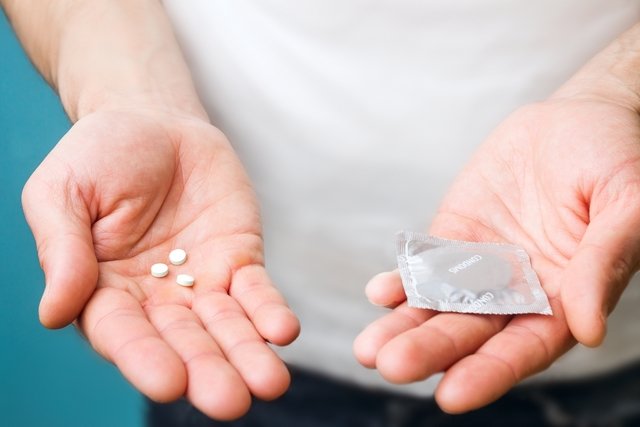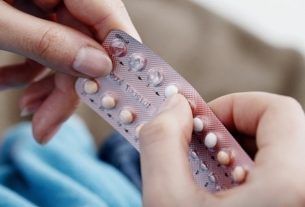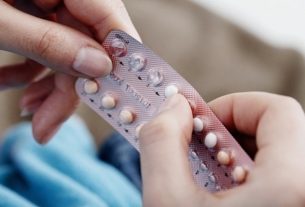The most commonly used male contraceptive methods are vasectomy and condoms, which prevent sperm from reaching the egg and generating a pregnancy.
Condoms are the most popular method, as they are more practical, reversible, effective and also provide protection against sexually transmitted diseases. Vasectomy, on the other hand, is a type of contraceptive with a definitive effect, as the doctor cuts the channel that leads sperm from the testicle to the penis, and this procedure is performed by men who no longer intend to have children.
In recent years, several studies have been carried out with the aim of creating a reversible contraceptive that is similar to the female contraceptive pill, giving men more options. Among the main male contraceptives that are in development, the gel contraceptive and the male pill, which act by reducing sperm production and motility, despite having reversible effects.

1. Condom
The condom, popularly called condom, is the contraceptive method most used by both men and women, as in addition to preventing pregnancy it also protects against diseases that can be transmitted sexually.
Furthermore, it does not cause any hormonal changes, nor does it alter the process of sperm production and release, being completely reversible.
See how to put on a condom correctly.
2. Vasectomy
Vasectomy is a male contraceptive method that involves cutting the tube that connects the testicle to the penis and which carries sperm. Thus, there is no release of sperm in the ejaculate and, consequently, fertilization cannot occur, preventing pregnancy.
This contraceptive method is normally used by men who do not wish to have more children, as, in most cases, it is irreversible. See how a vasectomy is performed and how it works.
3. Gel contraceptive
The gel contraceptive, known as Vasalgel, is a non-hormonal option, which is applied in the genital region, specifically in the vas deferens, which are the channels that carry sperm from the testicles to the penis, and works by blocking the passage of sperm for up to 10 years.
This procedure lasts around 15 minutes, is carried out under local anesthesia and it is possible to reverse the effect of this gel by applying a solvent to the place where the gel was placed.
The gel does not prevent ejaculation, only the passage of sperm. Vasalgel has no contraindications nor does it modify the production of male hormones, but more studies are still needed.
4. Male contraceptive pill
The male contraceptive pill, also called Dimethandrolone Undecanoate or DMAU, is a pill made up of derivatives of female hormones that works by reducing the amount of testosterone, which reduces sperm production and motility, temporarily interfering with a man’s fertility.
Despite having already been tested on some men, the male contraceptive pill is not yet available due to reported side effects, such as decreased libido, mood changes and increased acne, for example.
5. Contraceptive injection
Recently, an injection called RISUG was developed, made up of substances called polymers and is applied to the canal through which sperm pass, under local anesthesia. This injection blocks ejaculation, preventing sperm from escaping during sexual intercourse, and the drug’s action lasts between 10 and 15 years.
If the man wants to reverse the action of the injection, another medication that releases sperm can be applied. However, although the male contraceptive injection has already been tested, it is still in the process of being approved by government institutions responsible for releasing new medicines.
6. Retinoic acid inhibitors (DBAD)
Retinoic acid, which is present in vitamin A, has been shown to have an effect on male fertility, because a study indicated that the inhibition of a certain compound has an effect on the enzyme that synthesizes retinoid acid, causing a decrease in sperm production, preventing, thus, an unwanted pregnancy.
However, this method also influences alcohol metabolism, so studies in animal and human models had to be interrupted so that a better assessment of the contraceptive effect of this method could be carried out, in order to avoid interactions with this and other possible substances. .
7. H2-Gamendazol
The contraceptive H2-Gamendazol interferes with the process of sperm formation and differentiation. The use of this method has shown to be reversible at low doses, however, higher doses may have an irreversible effect and, therefore, more studies on animals are needed to determine the safe dose and, thus, be possible to carry out tests on humans with the objective of making H2-Gamendazole a non-permanent contraceptive.

Sign up for our newsletter and stay up to date with exclusive news
that can transform your routine!
Warning: Undefined array key "title" in /home/storelat/public_html/wp-content/plugins/link-whisper-premium/templates/frontend/related-posts.php on line 12
Warning: Undefined array key "title_tag" in /home/storelat/public_html/wp-content/plugins/link-whisper-premium/templates/frontend/related-posts.php on line 13



